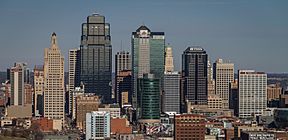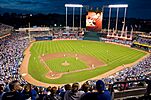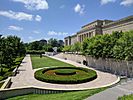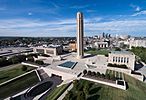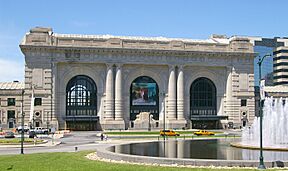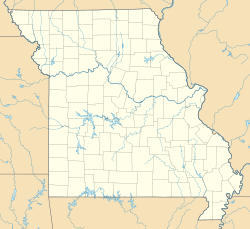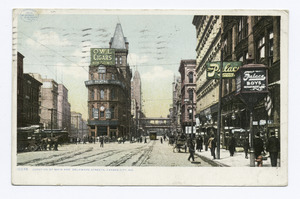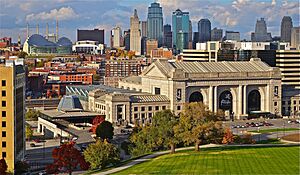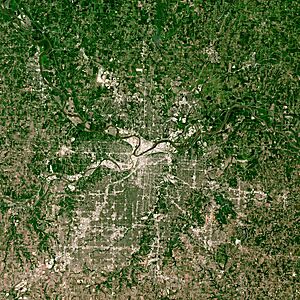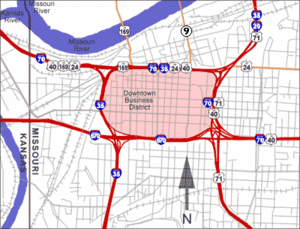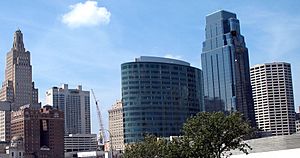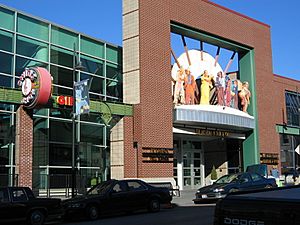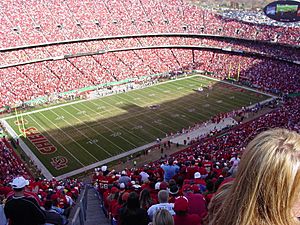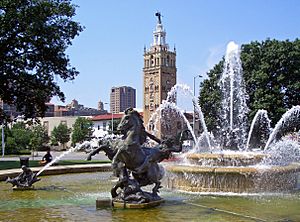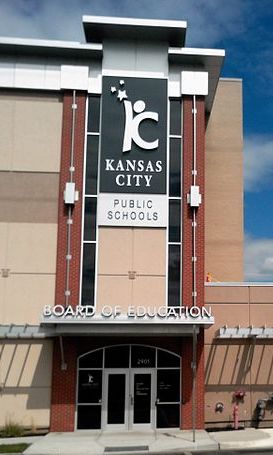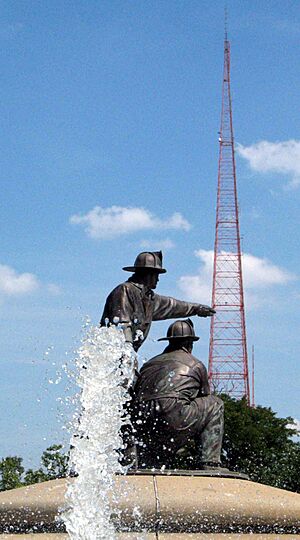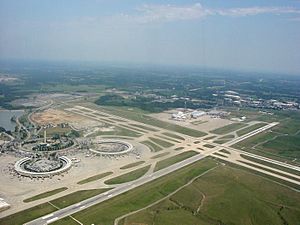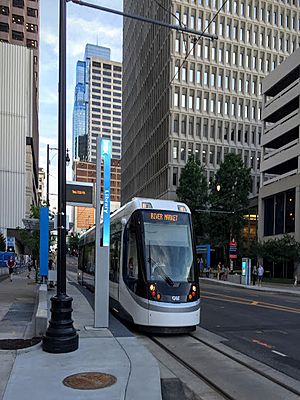Kansas City, Missouri facts for kids
Quick facts for kids
Kansas City, Missouri
|
|||
|---|---|---|---|
|
|||
| Nicknames:
"KC", "KCMO", the "City of Fountains", "Paris of the Plains", and the "Heart of America"
|
|||
| Country | United States | ||
| State | Missouri | ||
| Counties | Jackson, Clay, Platte, Cass | ||
| Incorporated (Town) | June 1, 1850 | ||
| Incorporated (City) | March 28, 1853 | ||
| Named for | Kansas River | ||
| Government | |||
| • Type | Council-manager | ||
| • Body | Kansas City, Missouri City Council | ||
| Area | |||
| • City | 318.80 sq mi (825.69 km2) | ||
| • Land | 314.73 sq mi (815.14 km2) | ||
| • Water | 4.07 sq mi (10.55 km2) 1.28% | ||
| • Urban | 714.10 sq mi (1,849.5 km2) | ||
| • Metro | 7,952.16 sq mi (20,596 km2) | ||
| Elevation | 910 ft (277 m) | ||
| Population
(2020)
|
|||
| • City | 508,090 | ||
| • Estimate
(2023)
|
510,704 | ||
| • Rank | 38th in the United States 1st in Missouri |
||
| • Density | 1,614.38/sq mi (623.31/km2) | ||
| • Urban | 1,674,218 (US: 34th) | ||
| • Urban density | 2,344.5/sq mi (905.2/km2) | ||
| • Metro | 2,392,035 (US: 31st) | ||
| Demonym(s) | Kansas Citian | ||
| GDP | |||
| • Metro | 9.501 billion (2022) | ||
| Time zone | UTC−06:00 (CST) | ||
| • Summer (DST) | UTC−05:00 (CDT) | ||
| ZIP Codes |
64XXX
|
||
| Area codes | 816, 975 | ||
| FIPS code | 29000–38000 | ||
| GNIS feature ID | 748198 | ||
Kansas City, Missouri (often called KC or KCMO) is the biggest city in the state of Missouri by both population and land area. Most of it is in Jackson County, but parts also reach into Clay, Platte, and Cass counties. It's the main city in the Kansas City metropolitan area, which crosses the Missouri and Kansas state line and is home to over 2.3 million people.
In 2020, Kansas City had about 508,090 residents, making it the 37th most populated city in the United States. It's also the largest city in the Midwest. Kansas City started in the 1830s as a port on the Missouri River, where it meets the Kansas River. The town was officially named Kansas on June 1, 1850. Later, to avoid confusion with the nearby Kansas Territory, it was renamed Kansas City.
The city sits on Missouri's western border with Kansas. Its downtown area is close to where the Kansas and Missouri Rivers meet. Kansas City covers about 319 square miles (826 km²), making it one of the largest cities in the U.S. by land area. It's known for its many fountains, its lively Kansas City jazz music scene, and delicious Kansas City–style barbecue. It's also home to popular sports teams like the Kansas City Chiefs (football) and the Kansas City Royals (baseball).
Contents
- Exploring Kansas City's Past
- Kansas City's Geography
- People of Kansas City
- Kansas City's Economy
- Kansas City's Culture and Fun
- Sports in Kansas City
- Parks and Green Spaces
- Education in Kansas City
- Media in Kansas City
- Getting Around Kansas City
- Sister Cities Around the World
- Famous People from Kansas City
- See also
Exploring Kansas City's Past
The town of Kansas, Missouri, became official on June 1, 1850. It was renamed the City of Kansas on March 28, 1853, and then Kansas City in 1889. The area where the Kansas and Missouri rivers meet was a great spot for people to settle.
Early Explorers and Settlers

Long ago, different Native American tribes like the Kansa and Osage lived here. The first European to visit this area was Étienne de Veniard, Sieur de Bourgmont in the early 1700s. He explored the Missouri River and described the meeting point of the "Grande Riv[ière] des Cansez" (Kansas River) and the Missouri River.
Later, the Spanish took control of the region, but French fur traders, like the Chouteau family, continued their business. In 1821, François Chouteau set up Chouteau's Landing in what is now Kansas City.
Growth After the Louisiana Purchase
After the Louisiana Purchase in 1803, Lewis and Clark explored the area and thought it would be a good place for a fort. In 1831, a group of Mormons settled here and built the first school. However, they were forced to leave by 1833.
In 1833, John Calvin McCoy started a town called West Port along the Santa Fe Trail, a few miles south of the river. He also created Westport Landing on the Missouri River to help transport goods. This landing area became the town of Kansas in 1850.
By this time, Kansas, Westport, and nearby Independence were important stops for people moving west. Major trails like the Santa Fe, California, and Oregon Trails all passed through this area. In 1853, the town was officially renamed the City of Kansas. It was about 0.70 square miles (1.8 km²) and had 2,500 people.
Kansas City During the Civil War
During the Civil War, Kansas City saw a lot of fighting. Even though Confederate soldiers won some battles nearby, Union troops held Kansas City because it was well-protected. The important Battle of Westport in 1864 ended the Confederates' attempts to take over Missouri.
After the Civil War: A City Transformed
After the Civil War, Kansas City grew very quickly. A big reason for this growth was the Hannibal and St. Joseph Railroad bridge built over the Missouri River in 1869. This bridge made Kansas City a major transportation hub. The city's population exploded, and in 1889, it was officially renamed Kansas City. By 1900, it was the 22nd largest city in the U.S.
A famous landscape architect named George Kessler helped design Kansas City with many beautiful boulevards and parks. This was part of the "City Beautiful" movement. Important landmarks like the new Union Station (opened in 1914) and the Liberty Memorial (opened in 1923) were built during this time. The Liberty Memorial is now the National World War I Museum and Memorial.
The Country Club Plaza, an innovative shopping area, opened in 1925. It was one of the first shopping districts designed for people arriving by car.
Streetcars and City Life
Kansas City once had a huge streetcar system with hundreds of miles of tracks. It was one of the biggest in the country! The 8th Street Tunnel was even built underground for streetcars in 1903. The last streetcar ran in 1957, but the tunnel is still there.
The Pendergast Era
In the early 1900s, political groups called "machines" became powerful in the city. One led by Tom Pendergast was very strong by 1925. Many important buildings, like the Kansas City City Hall, were built during this time. Pendergast also helped Harry S. Truman start his political career. Truman later became a U.S. Senator and then President. The machine lost its power in 1939 when Pendergast faced legal issues.
Neighborhood Changes
Troost Avenue used to be a fancy residential area. Over time, it became a dividing line in the city, separating neighborhoods by race and wealth. During the civil rights era, people of color were often prevented from moving to areas west of Troost. This led to challenges and higher crime rates in areas east of Troost.
From 1940 to 1970, Kansas City grew a lot in size by adding surrounding areas. This helped the city avoid losing as many people as some other big cities. However, some older neighborhoods still faced challenges with empty lots and abandoned homes, especially east of Troost.
Hyatt Regency Walkway Disaster
On July 17, 1981, a terrible accident happened at the Hyatt Regency hotel. A walkway collapsed, killing 114 people and injuring over 200. It was one of the deadliest building collapses in U.S. history. In 2015, a memorial called the Skywalk Memorial Plaza was built to honor the victims.
Kansas City in the 21st Century
In the 2000s, downtown Kansas City has been greatly improved with billions of dollars spent on new projects. The goal is to bring more visitors, businesses, and residents to the downtown area. Some major projects include:
- The Power & Light District, a new area with shops, restaurants, and entertainment.
- The T-Mobile Center, a large arena that opened in 2007 for sports and concerts.
- The Kauffman Center for the Performing Arts, which opened in 2011 and is home to the Kansas City Orchestra and Ballet.
Many old office buildings have been turned into apartments and hotels. The number of people living downtown has grown a lot, from about 4,000 in the early 2000s to nearly 30,000 by 2017.
Better Ways to Get Around
Transportation in Kansas City has also seen many improvements.
- The Metro Area Express (MAX) bus rapid transit system started in 2005. It connects popular areas like River Market, Downtown, Union Station, and the Country Club Plaza. MAX buses have special features like GPS tracking and traffic light control to stay on schedule.
- In 2016, the KC Streetcar began operating in downtown Kansas City. This two-mile (3.2 km) streetcar line runs between the River Market and Union Station. It's free to ride! Plans are underway to make the streetcar line even longer.
- A new, modern terminal opened at Kansas City International Airport in 2023, making travel easier for everyone.
Kansas City's Geography
Kansas City is located in the middle of the United States, where the Missouri River and Kansas River meet. The city has hills overlooking the rivers and flat areas near the river bottoms. It's known for its unique bowl shape, surrounded by limestone cliffs.
City Layout and Buildings
Kansas City has over 240 neighborhoods, each with its own history.
Amazing Architecture

Kansas City has many impressive buildings. The Nelson-Atkins Museum of Art and the Kauffman Center for the Performing Arts are examples of modern design. The Kansas City Power and Light Building is a tall building with a glowing light at the top, built in the Art Deco style. The Liberty Memorial, a World War I museum, has simulated flames that light up the night sky.
The city is also famous for its more than 200 working fountains, especially in the Country Club Plaza area. These fountains range from classic to modern designs.
City Market: A Historic Hub
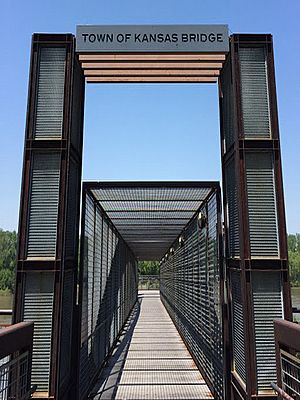
Since 1857, the City Market has been a popular public farmers' market. It connects local farmers and small businesses with the community. You can find fresh food, unique items, and restaurants there. The City Market also houses the Arabia Steamboat Museum, which displays items from a steamboat that sank in 1856.
Downtown and Beyond
Downtown Kansas City is the heart of the city, filled with exciting places.
- The 39th Street District is known for its many independent restaurants and shops.
- Crown Center is the headquarters of Hallmark Cards and has lots of shopping and entertainment. It's connected to Union Station by covered walkways.
- The Country Club Plaza is an upscale outdoor shopping and entertainment area. It was one of the first shopping districts designed for cars.
- Union Station is a historic train station that now has Science City, restaurants, and theaters.
The Power & Light District is a new entertainment area downtown with many restaurants, bars, and shops. It's anchored by the T-Mobile Center, a large sports and entertainment venue.
Kansas City's Climate
| Weather chart for Kansas City | |||||||||||||||||||||||||||||||||||||||||||||||
|---|---|---|---|---|---|---|---|---|---|---|---|---|---|---|---|---|---|---|---|---|---|---|---|---|---|---|---|---|---|---|---|---|---|---|---|---|---|---|---|---|---|---|---|---|---|---|---|
| J | F | M | A | M | J | J | A | S | O | N | D | ||||||||||||||||||||||||||||||||||||
|
1
40
22
|
1.5
45
26
|
2.1
57
36
|
3.9
67
46
|
5.1
76
57
|
5.3
86
67
|
4.4
90
72
|
4.7
89
70
|
3.8
80
61
|
3.2
68
49
|
1.8
55
36
|
1.3
44
27
|
||||||||||||||||||||||||||||||||||||
| temperatures in °F precipitation totals in inches |
|||||||||||||||||||||||||||||||||||||||||||||||
|
Metric conversion
|
|||||||||||||||||||||||||||||||||||||||||||||||
Kansas City has a climate with hot, humid summers and cold winters. Temperatures can change a lot throughout the year. In summer, it's often hot and sticky, with temperatures sometimes reaching over 100°F (38°C). Winters are cold, with snow and freezing temperatures.
The city is in Tornado Alley, an area where cold and warm air often meet, causing powerful storms and tornadoes, especially in spring. Kansas City has also experienced ice storms and flooding in the past.
People of Kansas City
| Historical population | |||
|---|---|---|---|
| Census | Pop. | %± | |
| 1860 | 4,418 | — | |
| 1870 | 32,260 | 630.2% | |
| 1880 | 55,785 | 72.9% | |
| 1890 | 132,716 | 137.9% | |
| 1900 | 163,752 | 23.4% | |
| 1910 | 248,381 | 51.7% | |
| 1920 | 324,410 | 30.6% | |
| 1930 | 399,746 | 23.2% | |
| 1940 | 400,178 | 0.1% | |
| 1950 | 456,622 | 14.1% | |
| 1960 | 475,539 | 4.1% | |
| 1970 | 507,087 | 6.6% | |
| 1980 | 448,159 | −11.6% | |
| 1990 | 435,146 | −2.9% | |
| 2000 | 441,545 | 1.5% | |
| 2010 | 459,787 | 4.1% | |
| 2020 | 508,090 | 10.5% | |
| 2023 (est.) | 510,704 | 11.1% | |
| U.S. Decennial Census 2010–2020 |
|||
Kansas City is a diverse city with people from many backgrounds. It has large populations of people with Somali and Sudanese heritage. The Latino/Hispanic population, mostly from Mexico and Central America, lives throughout the city, with some areas having more concentration. The Asian population, mainly from Southeast Asia, is also spread out, with some living in the River Market and Columbus Park neighborhoods.
The city's population has grown over the years. While some parts of the city have seen a decrease in residents, other areas, especially in the north and south, have grown.
| Historical racial composition | 2020 | 2010 | 1990 | 1970 | 1940 |
|---|---|---|---|---|---|
| White | 59.7% | 59.2% | 66.8% | 77.2% | 89.5% |
| Black or African American | 26.5% | 29.9% | 29.6% | 22.1% | 10.4% |
| Hispanic or Latino (of any race) | 10.7% | 10.0% | 3.9% | 2.7% | N/A |
| Two or more races | 6.3% | 3.2% | N/A | N/A | N/A |
| Asian | 2.7% | 2.5% | N/A | N/A | N/A |
| American Indian and Alaska Natives | 0.4% | 0.5% | N/A | N/A | N/A |
| Native Hawaiian and Other Pacific Islander | 0.3% | 0.2% | N/A | N/A | N/A |
In 2022, the city estimated about 3,000 people were experiencing homelessness.
| Race / Ethnicity (NH = Non-Hispanic) | Pop 2000 | Pop 2010 | Pop 2020 | % 2000 | % 2010 | % 2020 |
|---|---|---|---|---|---|---|
| White alone (NH) | 254,471 | 252,257 | 268,273 | 57.63% | 54.86% | 52.80% |
| Black or African American alone (NH) | 136,921 | 135,916 | 130,983 | 31.01% | 29.56% | 25.78% |
| Native American or Alaska Native alone (NH) | 1,784 | 1,823 | 1,854 | 0.40% | 0.40% | 0.36% |
| Asian alone (NH) | 8,100 | 11,275 | 15,793 | 1.83% | 2.45% | 3.11% |
| Pacific Islander alone (NH) | 442 | 787 | 1,456 | 0.10% | 0.17% | 0.29% |
| Other race alone (NH) | 757 | 709 | 2,366 | 0.17% | 0.15% | 0.47% |
| Mixed race or Multiracial (NH) | 8,466 | 11,067 | 26,396 | 1.92% | 2.41% | 5.20% |
| Hispanic or Latino (any race) | 30,604 | 45,953 | 60,969 | 6.93% | 9.99% | 12.00% |
| Total | 441,545 | 459,787 | 508,090 | 100.00% | 100.00% | 100.00% |
Kansas City's Economy
The U.S. federal government is the largest employer in the Kansas City area. Many government agencies have offices here, including a large Internal Revenue Service (IRS) center. The Honeywell company also operates a facility that makes non-nuclear parts for the U.S. nuclear defense system.
Kansas City is also a hub for animal health sciences. Companies like Dairy Farmers of America, the largest dairy co-op in the U.S., are based here. The Stowers Institute for Medical Research does important medical research.
The Federal Reserve Bank has one of its 12 U.S. headquarters in Kansas City. This helps manage the country's money supply. The national headquarters for the Veterans of Foreign Wars is also located here.
Kansas City's economy is strong, and it's a good place for real estate investment. Several large law firms are based in the city.
Companies Headquartered in KC
Many well-known companies have their main offices in Kansas City, Missouri:
- American Century Investments
- Andrews McMeel Universal
- Barkley Inc.
- Bernstein-Rein
- Blue Cross and Blue Shield of Kansas City
- BNIM
- Boulevard Brewing Company
- Burns & McDonnell
- Cerner
- Children International
- Commerce Bancshares
- Copaken, White & Blitt
- Evergy
- Freightquote.com
- Garney Holding Company
- H&R Block
- Hallmark Cards
- HNTB
- Hostess Brands
- J.E. Dunn Construction Group
- JHS Pedals
- Kansas City Southern Railway
- Lockton Companies
- MANICA Architecture
- Populous
- Russell Stover Candies
- Smith Electric Vehicles
- UMB Financial Corporation
- Veterans of Foreign Wars
- Walton Construction
Major Employers in the City
Here are some of the biggest employers in Kansas City:
| Rank | Employer | Employees | Percentage of total employment |
|---|---|---|---|
| 1. | Public school system | 30,172 | 2.92% |
| 2. | Federal government | 30,000 | 2.91% |
| 3. | State/county/city government | 24,616 | 2.39% |
| 4. | Cerner Corporation | 10,128 | 0.98% |
| 5. | HCA Midwest Health System | 9,753 | 0.94% |
| 6. | Saint Luke's Health System | 7,550 | 0.73% |
| 7. | Children's Mercy Hospitals and Clinics | 6,305 | 0.61% |
| 8. | T-Mobile | 6,300 | 0.61% |
| 9. | The University of Kansas Hospital | 6,030 | 0.58% |
| 10. | Hallmark Cards, Inc. | 4,600 | 0.45% |
Kansas City's Culture and Fun
Nicknames and What They Mean
Kansas City, Missouri, is often called KCMO or simply KC. Its residents are known as Kansas Citians. It's officially nicknamed the "City of Fountains" because it has so many beautiful fountains. The fountains at Kauffman Stadium are the largest privately funded fountains in the world!
In 2018, UNESCO named Kansas City the first and only "City of Music" in the U.S. This was because of its rich musical history and its support for music and arts. The city also has more boulevards than almost any other city, earning it the nickname "Paris of the Plains." Because of its central location, it's also called the "Heart of America."
Performing Arts Scene
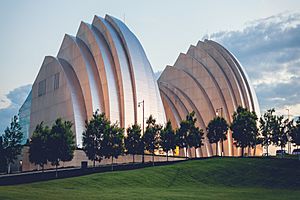
Kansas City has a thriving performing arts scene. In the early 1900s, it was a major center for vaudevillian shows.
- The Kansas City Repertory Theatre is the area's top professional theater company.
- The Starlight Theatre is a huge outdoor theater with over 8,000 seats.
- The Kansas City Symphony performs at the Kauffman Center for the Performing Arts.
- The Lyric Opera of Kansas City and the Civic Opera Theater also offer opera performances.
- Every summer, the Heart of America Shakespeare Festival performs plays by Shakespeare in Southmoreland Park.
- The Kansas City Ballet performs classical and modern ballets at the Kauffman Center.
The Sound of Kansas City Jazz
Kansas City jazz was very important in the 1930s, helping to change music from big bands to the bebop style. The city has a strong history of jazz music, especially in the 18th and Vine neighborhood.
Many live music venues can be found throughout the city, particularly in the Westport entertainment district. Kansas City has been home to many famous musicians and bands across different genres. The Kansas City Jazz Orchestra plays big band style jazz.
In 2018, UNESCO recognized Kansas City as a "City of Music" because of its deep musical roots and its efforts to support the 18th and Vine Jazz District.
Irish Culture in KC
Kansas City has a large population of people with Irish heritage. The Irish were among the first big immigrant groups to settle here. The city has Irish bands, dancers, shops, and the Kansas City Irish Center. The Kansas City Irish Fest is a popular event held every year.
Casinos for Fun
Missouri voters approved riverboat casinos in 1992. Kansas City and its surrounding area are home to six casinos, offering various games and entertainment.
Delicious Kansas City Cuisine

Kansas City is famous for its amazing steak and Kansas City-style barbecue. In the past, when the Kansas City Stockyards were busy, the city was known for its "Kansas City strip steaks." The Golden Ox steakhouse, located in the old stockyards, is very famous.
Kansas City is considered one of the "world capitals of barbecue," along with places like Texas and Memphis. There are over 90 barbecue restaurants in the area! The American Royal hosts what it claims is the world's biggest barbecue contest every fall.
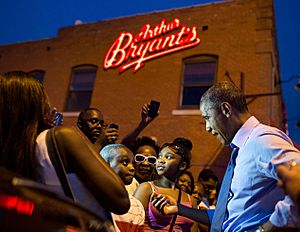
Kansas City-style barbecue started with Henry Perry, who opened the city's first barbecue stand in 1921. His restaurant was later taken over by Arthur Bryant's. Another popular barbecue spot is Gates and Sons Bar-B-Q. The famous KC Masterpiece barbecue sauce, known for using molasses, also came from Kansas City.
Many chefs and restaurants in Kansas City have won or been nominated for prestigious James Beard Awards, showing the city's strong food scene.
Cool Places to Visit
| Name | Description | Photo |
|---|---|---|
| Country Club Plaza District | This area, built in 1922, has Spanish-style buildings, fancy shops, and restaurants. Nearby are the University of Missouri–Kansas City, the Kansas City Art Institute, and the Nelson-Atkins Museum of Art. | 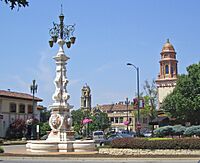 |
| 18th and Vine | This historic district is known for its unique Kansas City jazz. It's home to the Negro Leagues Baseball Museum and the American Jazz Museum. You can also find jazz clubs like the Gem Theater here. | 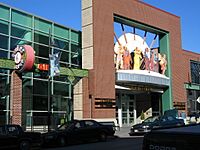 |
| Crossroads Arts District | This district is full of restaurants, art galleries, and hotels. On the first Friday of each month, there's a special event with pop-up galleries, food trucks, and music. Union Station and the Kauffman Center are also in this area. | 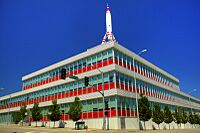 |
| Westport District | Westport was once a separate town. Now, it's part of Kansas City and has many restaurants, shops, and nightlife options. It's one of the city's main entertainment areas. | 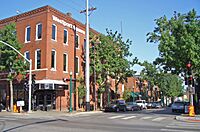 |
| Power and Light District | This is a new shopping and entertainment area downtown. It features the T-Mobile Center and the Midland Theatre, a concert venue. | 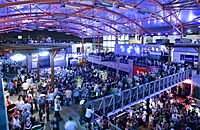 |
| River Market District/ Berkley Riverfront Park | Kansas City's oldest neighborhood, located on the Missouri River. It has one of the country's largest and oldest public farmers' markets and the Steamboat Arabia Museum. The new streetcar line runs through this area. |  |
| Crown Center | This complex was developed by Hallmark Cards. It's a short walk from the National World War I Museum and Memorial (Liberty Memorial). |  |
| West Bottoms | The West Bottoms used to be mainly for stockyards and industry. Now, it's being updated with apartments and shops. Kemper Arena is located here. | 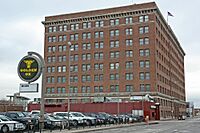 |
| Kansas City, North | North of the Missouri River, you'll find attractions like Zona Rosa (a shopping and dining area), the Aviation History Museum at the Charles B. Wheeler Downtown Airport, and the popular amusement parks Worlds of Fun and Oceans of Fun. | 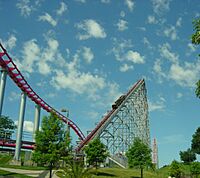 |
| Swope Park | Swope Park is one of the largest city parks in the U.S., bigger than New York City's Central Park. It includes the Kansas City Zoo, Starlight Theatre, golf courses, and lakes. |  |
Religious Life
About half of Kansas City residents have a religious affiliation. The most common religions are Catholic, Baptist, and other Christian faiths. There are also smaller communities of Latter-day Saints, Lutherans, Presbyterians, Jewish, Eastern religions, and Islam.
Walt Disney's Connection to KC
In 1911, Walt Disney's family moved to Kansas City. Walt later started his first animation company, Laugh-O-Gram Studio, in Kansas City. It was here that he designed Mickey Mouse. After this company faced challenges, Walt Disney moved to Hollywood and started The Walt Disney Company in 1923.
Sports in Kansas City
Kansas City is home to several professional sports teams:
- The Kansas City Chiefs (NFL football)
- The Kansas City Royals (MLB baseball)
- Sporting Kansas City (MLS soccer)
| Club | Sport | Founded | League | Venue |
|---|---|---|---|---|
| Kansas City Chiefs | Football | 1960 (as the Dallas Texans) 1963 (as Kansas City Chiefs) |
National Football League | Arrowhead Stadium |
| Kansas City Royals | Baseball | 1969 | Major League Baseball | Kauffman Stadium |
| Sporting Kansas City | Soccer | 1996 | Major League Soccer | Children's Mercy Park (Kansas City, Kansas) |
| Sporting Kansas City II | Soccer | 2016 | MLS Next Pro | Children's Mercy Park (Kansas City, Kansas) |
| Kansas City Current | Soccer | 2018 (as Utah Royals FC)
2021 (as KC NWSL) |
National Women's Soccer League | Children's Mercy Park (Kansas City, Kansas) |
| Kansas City Mavericks | Hockey | 2009 | ECHL | Cable Dahmer Arena (Independence) |
| Kansas City Comets | Indoor soccer | 2010 | Major Arena Soccer League | Cable Dahmer Arena (Independence) |
| Kansas City Monarchs | Baseball | 1993 (as the Duluth-Superior Dukes)
2003 (as the Kansas City T-Bones) |
American Association | Legends Field |
| Kansas City Blues | Rugby union | 1966 | USA Rugby Division 1 | Swope Park Training Complex |
| Kansas City Storm | Women's football | 2004 | WTFA | North Kansas City High School |
| Kansas City Goats | Arena football | 2023 | The Arena League | Municipal Arena |
Football Fun with the Chiefs
The Kansas City Chiefs started as the Dallas Texans in 1960 and moved to Kansas City in 1963. They won Super Bowl IV in 1969, and more recently, they won Super Bowl LIV in 2020, Super Bowl LVII in 2023, and Super Bowl LVIII in 2024!
Baseball with the Royals

The Kansas City Royals baseball team started in 1969. They are the only major league sports team in Kansas City that has never moved or changed its name. The Royals won the World Series in 1985 and again in 2015.
The Kansas City Monarchs are a local minor league baseball team. They play at Legends Field in Kansas City, Kansas.
Soccer Excitement
Sporting Kansas City is the city's professional soccer team, playing in Major League Soccer (MLS). They moved to their new stadium, Children's Mercy Park, in 2011. They have won the MLS Cup twice and the U.S. Open Cup four times.
The Kansas City Current is the city's professional women's soccer team, playing in the National Women's Soccer League. They are building a new soccer stadium on the Berkley Riverfront Park, planned to open in 2024.
Kansas City was chosen as one of the U.S. host cities for the 2026 FIFA World Cup!
College Sports
Kansas City hosts the Big 12 College Basketball Tournaments. The men's tournament is held at the T-Mobile Center, and the women's tournament is at Municipal Auditorium. The University of Missouri–Kansas City (UMKC) has a Division I sports program called the Kansas City Roos.
Parks and Green Spaces
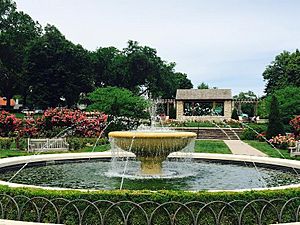
Kansas City is known for its many boulevards and parks. It has 132 miles (212 km) of boulevards, 214 urban parks, and 49 ornamental fountains. Much of this system was designed by George E. Kessler between 1893 and 1915.
- Cliff Drive, in Kessler Park, is a special State Scenic Byway with historical landmarks.
- Ward Parkway is a beautiful street lined with large, historic homes.
- The Paseo is a major north-south parkway that runs through the city.
- Swope Park is one of the largest city parks in the nation, covering over 1,800 acres (7.3 km²). It includes the Kansas City Zoo, two golf courses, and the Starlight Theatre.
- Berkley Riverfront Park, on the Missouri River, hosts annual Independence Day celebrations and other festivals.
In 1974, the Kansas City Park and Boulevard System was recognized as a National Historic Civil Engineering Landmark for its innovative design.
Education in Kansas City
Kansas City has many universities, colleges, and seminaries.
Colleges and Universities
- University of Missouri–Kansas City (UMKC) – a large university with over 15,000 students.
- Rockhurst University – a Jesuit university founded in 1910.
- Kansas City Art Institute – a four-year college for fine arts and design.
- Kansas City University – a medical and graduate school.
- Avila University – a Catholic university.
- Park University – a private institution with several branches.
- William Jewell College – a private liberal arts college.
- Metropolitan Community College – a two-year college with multiple campuses.
Schools for Kids
Kansas City is served by 15 different public school districts, not just one. This is because suburban areas kept their own school districts as the city grew. There are also many private schools, including Catholic schools.
The public school districts serving Kansas City include:
- In Jackson County: Kansas City Public Schools, Blue Springs R-4 School District, Center School District, Fort Osage R-1 School District, Grandview C-4 School District, Hickman Mills C-1 School District, Independence School District, Lees Summit R-7 School District, Raytown C-2 School District.
- In Cass County: Belton School District.
- In Clay County: Liberty Public School District, North Kansas City School District, Smithville School District.
- In Platte County: Park Hill School District, Platte County R-3 School District.
Libraries and Archives
Kansas City has several important libraries and archives:
- Linda Hall Library – a well-known library for science, engineering, and technology.
- Mid-Continent Public Library – the largest public library system in Missouri.
- Kansas City Public Library – the oldest library system in Kansas City.
- University of Missouri-Kansas City Libraries – includes several collections for law, health sciences, and general studies.
- The Black Archives of Mid-America – a research center focused on the African American experience in the Midwest.
- National Archives and Records Administration (NARA), Central Plains Region – one of the national facilities holding millions of historical records.
Media in Kansas City
Newspapers and Magazines
The Kansas City Star is the main newspaper in the area. It was first published in 1880. Other weekly newspapers include The Call (for the African-American community), the Kansas City Business Journal, and The Pitch. There are also bilingual publications like Dos Mundos.
TV and Radio
Kansas City has many television and radio stations. Some famous national TV and radio personalities, like Walter Cronkite, started their careers here. The major TV networks all have affiliates in Kansas City, including Fox (WDAF-TV), CBS (KCTV), ABC (KMBC-TV), NBC (KSHB-TV), and PBS (KCPT).
Film and Movies
Kansas City has been a location for many films and TV shows. The Calvin Company, a large film production company, was based here for many years. Famous director Robert Altman made some of his early movies in Kansas City.
The 1983 TV movie The Day After was filmed in Kansas City and Lawrence, Kansas. Other movies shot in or around the city include Truman and Paper Moon.
Today, Kansas City has a growing independent film community. The city launched the KC Film Office to attract more film and TV productions.
Getting Around Kansas City
Kansas City was once a starting point for travelers on famous trails like the Santa Fe Trail and Oregon Trail. Later, it became a major railroad hub. More train cargo passes through Kansas City than any other U.S. city.
Highways and Roads
Kansas City has a huge network of highways. Interstate 435, which goes all the way around the city, is one of the longest beltways in the country. The Kansas City area has more highway lanes per person than almost any other large U.S. city. This helps make it a major center for shipping and logistics.
Major interstate highways that meet in Kansas City include: I-29, I-35, I-49, I-70, I-435, I-470, I-635, and I-670.
Airports for Travel
Kansas City International Airport (MCI) is the city's main airport. A brand new, modern terminal opened in 2023. Charles B. Wheeler Downtown Airport (MKC) is used for smaller planes and airshows, and it's where the Airline History Museum is located.
Public Transportation Options
Kansas City used to have a large streetcar system, but it closed in 1957. Now, the city has modern public transportation.
RideKC Buses and MAX
The Kansas City Area Transportation Authority (KCATA) manages the public transit system, called RideKC. In 2005, the KCATA launched the Metro Area Express (MAX), a special bus rapid transit line. MAX buses have features like GPS tracking and can even change traffic lights to stay on time. There are MAX lines connecting River Market, Downtown, Union Station, Crown Center, and the Country Club Plaza.
RideKC Streetcar
In 2016, the KC Streetcar started operating in downtown Kansas City. This streetcar line runs along Main Street from the River Market to Union Station. The best part is, it's free to ride! There are plans to make the streetcar line even longer in the future.
RideKC Bridj
RideKC Bridj is a newer service that works like a taxi service, but you can use a mobile app to request a ride.
Trains for Longer Trips
Amtrak offers train services from Union Station. You can take the Southwest Chief to Chicago or Los Angeles, or the Missouri River Runner to St. Louis.
Walking Around Kansas City
Kansas City is becoming more walkable. A 2015 study ranked it as the 42nd most walkable out of the 50 largest U.S. cities. Some neighborhoods, like Westport and the Downtown Loop, are very walkable. The city has also approved funds for sidewalk repairs and making streets more friendly for walkers and bikers.
Sister Cities Around the World
Kansas City has 15 sister cities in different countries. These partnerships help promote cultural exchange and understanding.
| City | Subdivision | Country | Date |
|---|---|---|---|
| Seville | 1967 | ||
| Kurashiki | 1972 | ||
| Morelia | 1973 | ||
| Freetown | Western Area | 1974 | |
| Tainan | 1978 | ||
| Xi'an | Shaanxi | 1989 | |
| Guadalajara | 1991 | ||
| Hannover | 1993 | ||
| Port Harcourt | Rivers State | 1993 | |
| Arusha | Arusha Region | 1995 | |
| San Nicolás de los Garza | 1997 | ||
| Ramla | 1998 | ||
| Metz | 2004 | ||
| Yan'an | Shaanxi | 2017 | |
| Kabul | Kabul Province | 2018 |
Famous People from Kansas City
Many well-known people have lived in Kansas City, including:
- Cartoonists: Walt Disney, Friz Freleng, and Ub Iwerks
- Musicians: Count Basie and Tech N9ne
- Actors: Don Cheadle and Chris Cooper
- Politicians: Emanuel Cleaver and Tom Pendergast
- Reporter: Walter Cronkite
See also
 In Spanish: Kansas City (Misuri) para niños
In Spanish: Kansas City (Misuri) para niños


